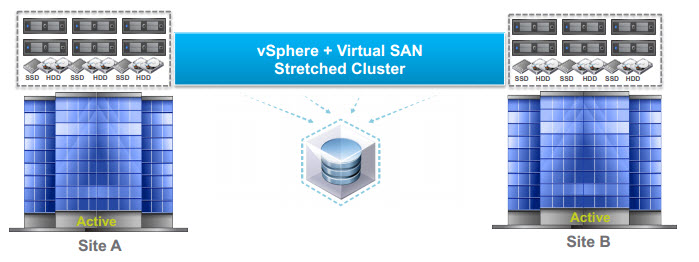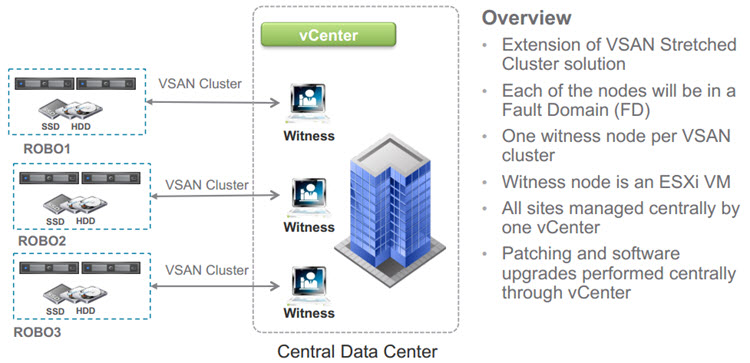Browse All Articles > VMware Virtual SAN 6.1: What's new
Finally comes the third version of VMware Virtual SAN, whose name is 6.1, and comes loaded with new features many of which really are excellent and even surprising.
There is no doubt that the Software Defined Storage (SDS) is a critical point that VMware aims to improve storage management, to use specific hardware features to enhance performance using the software to control efficiently given by hardware layer.
In this new generation much more companies of various sizes have implemented their technology, because Virtual SAN simplifies data center accelerating applications and reducing IT costs associated with storage. It also provides advanced storage services for virtual machines, including configurations as completely based on flash reaches up to 90,000 IOPS, support vSphere Fault Tolerance (FT), asynchronous replication with an RPO of 5 minutes or less and cluster support extended for high availability.
Simplify and optimize storage in both the provisioning and management in vSphere environments and reduces up to 50% TCO. This is accomplished as previously stated leveraging standard x86 server hardware.
Virtual SAN has the fundamental feature a predictable, elastic and non-disruptive storage resource scalability. Thus, massive and costly upgrades of storage systems are removed in order to maintain compatibility with a single additional application that is not part of the existing hardware.
This version incorporates Virtual SAN enterprise-class features such as:
![Stratched.jpg]()
Virtual SAN has the ability to create a stretch cluster and replicate data synchronously between two geographically separated sites, which provides enterprise-class availability and ensures that no data loss and downtime almost zero, even if a complete site failure occurs.
With the new integration with vRealize Operations, a comprehensive set of management functions whereby the troubleshooting time is reduced it is provided, the monitoring is improved and overall visibility of Virtual SAN clusters is obtained.
Using a free add vCenter, checks driver compatibility, firmware and hardware are provided, network diagnostics are performed in real time and consistency for advanced cluster configuration options is guaranteed.
Now the Virtual SAN datastore can be used to provide persistent storage for applications that are in the Docker containers.
By leveraging the advantages of a flexible storage solution defined by the software, new features and hardware configurations, such as added:
• Support for two-node clusters: It is now possible to implement a two-node cluster and high availability in different data centers to enhance the solution, making it hyper convergent and economically suitable for places with limited storage. Recall that until version 6.0 minimum cluster nodes was 3 hosts.
![Dosnodos.jpg]()
• Solid State Drives DIMM-based: It is now possible to link the channel flash memory storage system through the DIMM slots, allowing generate a write latency of less than 5 ms.
• NVMe SSD: new SSDs with improved communications to achieve even better performance of these devices are supported protocol.
With regard to the requirements of network Virtual SAN 6.1 requires a 5ms latency on networks 10 / 40Gb. For connectivity failover domains or Witness Appliance, requirements are 500ms requirements for a 100 Mb connectivity, which applies perfectly to vCloud Air domains at remote sites. This new feature is highlighted as the remote site itself adds additional latency to be added to the local site.
With such added features can be held together multiple vCloud Air sites with Virtual SAN and use vSphere Replication in order to have DR alternatives. And in the case of not having vCloud Air can use a remote site with Site Recovery Manager (SRM) as Virtual SAN using VSANs Sparse Snapshot mechanism that is much more efficient (soon I will publish an article explaining in detail the technology article)
Fault Tolerance is now fully supported in Virtual SAN, although not on extended clusters. The secondary copy can be stored on a separate domain and requires a 10Gb network.
Oracle are now supported (Real Application Cluster) RAC, Microsoft Exchange Cluster (DAG) and SQL Server Always-On.
Among the improvements that can be appreciated in this regard the most notable are:
• Claim massive disk-based architecture of Virtual SAN
• Enhanced claim capacity
• Reclaiming cache space
• Grouping disk by model and size
As you can see, improvements in Virtual SAN are more than interesting and continue to prove that VMware's interest in software-defined storage continues to grow. If we had the features in version 6.0 we add just described briefly in this article we get a fully designed to provide high levels of performance as well as support leg environments of all sizes environment.
Thanks for reading, and please share on your social networks
In this new generation much more companies of various sizes have implemented their technology, because Virtual SAN simplifies data center accelerating applications and reducing IT costs associated with storage. It also provides advanced storage services for virtual machines, including configurations as completely based on flash reaches up to 90,000 IOPS, support vSphere Fault Tolerance (FT), asynchronous replication with an RPO of 5 minutes or less and cluster support extended for high availability.
Simplify and optimize storage in both the provisioning and management in vSphere environments and reduces up to 50% TCO. This is accomplished as previously stated leveraging standard x86 server hardware.
Virtual SAN has the fundamental feature a predictable, elastic and non-disruptive storage resource scalability. Thus, massive and costly upgrades of storage systems are removed in order to maintain compatibility with a single additional application that is not part of the existing hardware.
News and features
This version incorporates Virtual SAN enterprise-class features such as:
Stretched Cluster

Virtual SAN has the ability to create a stretch cluster and replicate data synchronously between two geographically separated sites, which provides enterprise-class availability and ensures that no data loss and downtime almost zero, even if a complete site failure occurs.
Virtual SAN Management Pack for Operations vRealize
With the new integration with vRealize Operations, a comprehensive set of management functions whereby the troubleshooting time is reduced it is provided, the monitoring is improved and overall visibility of Virtual SAN clusters is obtained.
VSAN health check plugin
Using a free add vCenter, checks driver compatibility, firmware and hardware are provided, network diagnostics are performed in real time and consistency for advanced cluster configuration options is guaranteed.
Compatibility with native cloud applications
Now the Virtual SAN datastore can be used to provide persistent storage for applications that are in the Docker containers.
New hardware options
By leveraging the advantages of a flexible storage solution defined by the software, new features and hardware configurations, such as added:
• Support for two-node clusters: It is now possible to implement a two-node cluster and high availability in different data centers to enhance the solution, making it hyper convergent and economically suitable for places with limited storage. Recall that until version 6.0 minimum cluster nodes was 3 hosts.

• Solid State Drives DIMM-based: It is now possible to link the channel flash memory storage system through the DIMM slots, allowing generate a write latency of less than 5 ms.
• NVMe SSD: new SSDs with improved communications to achieve even better performance of these devices are supported protocol.
Network latency
With regard to the requirements of network Virtual SAN 6.1 requires a 5ms latency on networks 10 / 40Gb. For connectivity failover domains or Witness Appliance, requirements are 500ms requirements for a 100 Mb connectivity, which applies perfectly to vCloud Air domains at remote sites. This new feature is highlighted as the remote site itself adds additional latency to be added to the local site.
With such added features can be held together multiple vCloud Air sites with Virtual SAN and use vSphere Replication in order to have DR alternatives. And in the case of not having vCloud Air can use a remote site with Site Recovery Manager (SRM) as Virtual SAN using VSANs Sparse Snapshot mechanism that is much more efficient (soon I will publish an article explaining in detail the technology article)
Support vSphere FT
Fault Tolerance is now fully supported in Virtual SAN, although not on extended clusters. The secondary copy can be stored on a separate domain and requires a 10Gb network.
Support for clustering technologies
Oracle are now supported (Real Application Cluster) RAC, Microsoft Exchange Cluster (DAG) and SQL Server Always-On.
Improved handling discs
Among the improvements that can be appreciated in this regard the most notable are:
• Claim massive disk-based architecture of Virtual SAN
• Enhanced claim capacity
• Reclaiming cache space
• Grouping disk by model and size
As you can see, improvements in Virtual SAN are more than interesting and continue to prove that VMware's interest in software-defined storage continues to grow. If we had the features in version 6.0 we add just described briefly in this article we get a fully designed to provide high levels of performance as well as support leg environments of all sizes environment.
Thanks for reading, and please share on your social networks
Have a question about something in this article? You can receive help directly from the article author. Sign up for a free trial to get started.


Comments (0)